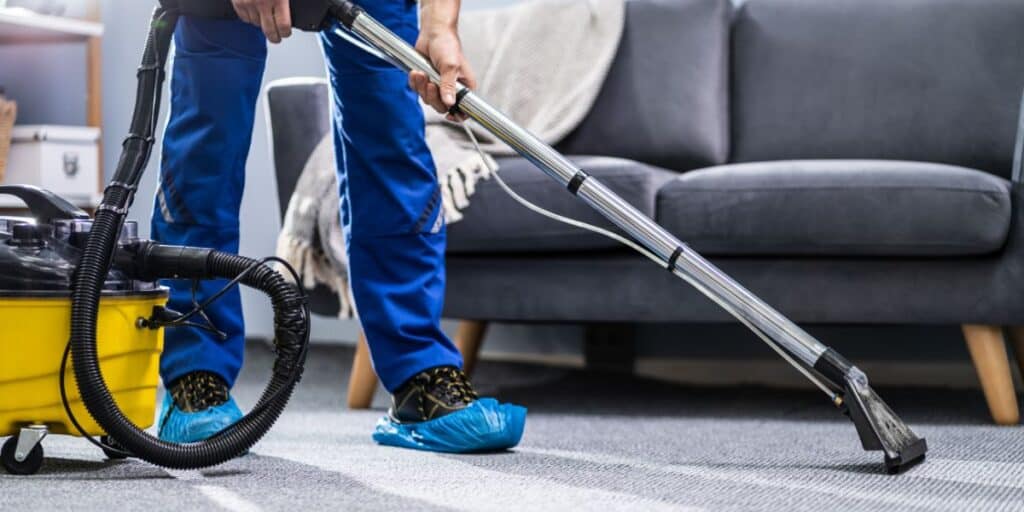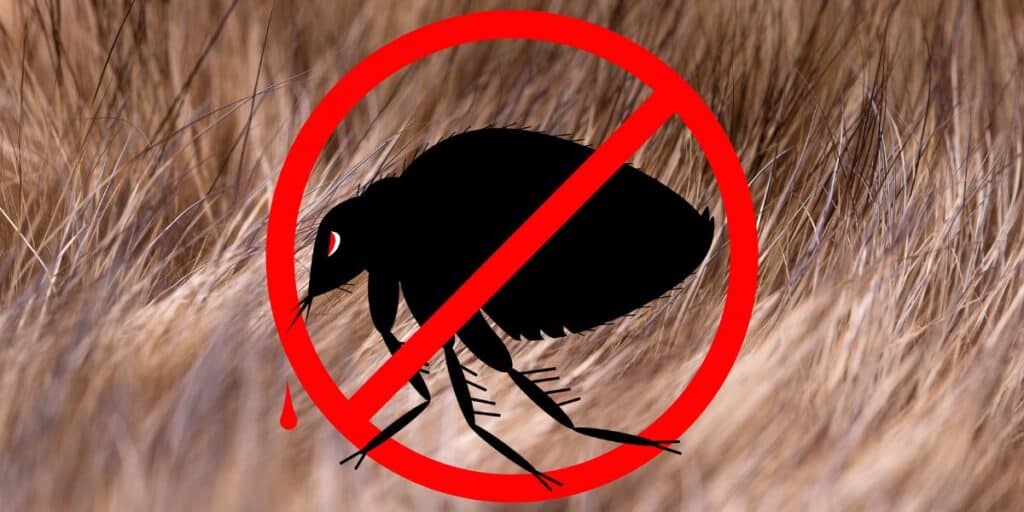Are you tired of dealing with fleas in your home and wondering if carpet cleaning can put an end to them? Carpets are certainly a cozy hiding place for fleas, their eggs, and their larvae, making it essential for homeowners to find an effective way to tackle this issue. In this article, we’ll discuss the effectiveness of carpet cleaning when it comes to flea extermination.
In short, carpet cleaning can indeed help kill fleas. With thorough vacuuming, steam cleaning, and appropriate feal treatment products, you can get rid of fleas from your home environment. However, in case of a major infestation, carpet cleaning alone might not completely solve the problem.
As you continue reading this article, we will explore the best carpet cleaning methods to eradicate fleas, as well as provide tips on how to prevent future infestations. Moreover, we’ll discuss the importance of taking a comprehensive approach which includes treating your pets and other areas in the house where fleas might be thriving. So, let’s dive in and help you make your home a flea-free sanctuary!

Understanding Fleas
Fleas are small, wingless insects that survive by feeding on the blood of their hosts. These pests can cause significant discomfort for humans and pets, as well as spread disease. In this section, we will dive into the life cycle, habits and behaviors, and the impact of fleas on the home environment and health to better understand how carpet cleaning can help control their populations.
Life Cycle
The life cycle of a flea consists of four stages: egg, larva, pupa, and adult. Adult fleas lay eggs on their host or in the surrounding environment. The eggs then hatch into larvae, which feed on organic matter such as adult flea feces, pet hair, and dead skin cells. After a while, the larvae spin a cocoon and enter the pupal stage. When the conditions are right, an adult flea emerges from the pupa, ready to feed on a host and start the cycle over again.
Habits and Behaviors
Fleas are strong jumpers, allowing them to easily move between hosts and across a home environment. They are attracted to warmth, movement, and carbon dioxide emitted by their potential host. Fleas mainly feed during the day, but can be active at night as well. They prefer pets with dense fur, such as dogs and cats, as hiding spots, but will also bite humans if there are no other suitable hosts available.
The Impact of Fleas on Home Environment and Health
Fleas can cause a variety of health issues for both humans and pets. Their bites often result in itchy, red bumps that can lead to secondary infections if scratched excessively. Pets may suffer from flea allergy dermatitis, an allergic reaction to flea saliva, causing severe itching, hair loss, and irritation. Moreover, fleas can transmit diseases and parasites, such as tapeworms and bacterial infections.
A flea infestation in your home can be very disruptive to your daily life. Besides the constant itching and bites, fleas can be difficult to combat due to their rapid reproduction rate and persistence in the environment. Additionally, fleas can lay eggs in carpets, upholstery, and other household items, making them difficult to eradicate without extensive cleaning efforts.
By understanding the life cycle, habits, and behaviors of fleas, as well as their impact on the home environment and health, you are better equipped to treat and prevent infestations. Regular carpet cleaning, alongside other preventative measures, can make a significant difference in controlling and reducing flea populations in your home.
Understanding the Connection: Carpets and Fleas
When it comes to dealing with fleas in your home, carpets often provide the perfect environment for these pesky pests to thrive. In this section, we’ll explore the connection between carpets and fleas in more detail, focusing on why fleas are drawn to carpets and how they infest them.
Why Fleas Love Carpets?
Fleas are small insects that feed on the blood of animals, and they are known for their ability to jump long distances. Carpets offer an ideal breeding ground for fleas due to several factors:
- Warmth: Fleas are attracted to the warmth provided by carpets, especially those in rooms with underfloor heating or that receive direct sunlight.
- Fiber texture: The thick fibers of carpets create a comfortable environment for fleas to lay their eggs and hide from potential threats.
- Access to a food source: Fleas prefer to live close to their hosts, and carpets in living areas where pets and humans spend time provide easy access to their next meal.
By understanding the factors that make carpets so attractive to fleas, you can take steps to mitigate their presence in your home.
How Fleas Infest Carpets?
The process of fleas infesting carpets typically starts when an adult flea lays eggs on a host animal (such as your pet). These eggs then fall off the host and end up in your carpets. The development of fleas involves four distinct stages: eggs, larvae, pupae, and adults. Here’s a brief overview of this life cycle in relation to carpet infestation:
- Eggs: Flea eggs are small, white, and nearly transparent. They can be difficult to see, especially when hidden in the fibers of a carpet. Over the course of 1-10 days, these eggs hatch into larvae.
- Larvae: Flea larvae are tiny, worm-like in appearance, and have voracious appetites. They feed on organic debris within the carpet, including adult flea feces which contains partially digested blood from the host. Larvae typically molt through three stages before becoming pupae.
- Pupae: At this stage, the developing flea is encased in a cocoon-like structure. The pupa stage can last anywhere from 1-4 weeks or even longer, depending on environmental conditions. Pupae can be incredibly resilient against chemical treatments.
- Adult fleas: Adult fleas emerge from their cocoons when they sense the presence of a host through vibrations, warmth, and carbon dioxide. Once they have emerged, they seek out a host to complete the cycle.

Considering all these factors, you now have a clearer understanding of the relationship between carpets and fleas, and how the infestation process unfolds. Regular carpet cleaning can be a valuable tool in disrupting this life cycle and reducing the population of fleas in your home.
Remember:
- Carpets provide warmth, texture, and access to food for fleas
- Fleas go through a life cycle consisting of eggs, larvae, pupae, and adults within carpets
- Regular carpet cleaning can help to reduce flea infestations in your home
Different Carpet Cleaning Methods And Their Effectiveness Against Fleas
When it comes to dealing with fleas in your carpet, choosing the right carpet cleaning method can make a significant difference. In this section, we will briefly explain three common carpet cleaning methods: Steam Cleaning, Dry Cleaning, and Bonnet Cleaning. Then, we will compare their relative effectiveness against fleas, using a table to make it easy for you to understand.
Steam Cleaning, also known as hot water extraction, involves spraying hot water mixed with cleaning agents onto the carpet. A high-powered vacuum then extracts the water, dirt, and dead fleas. Steam cleaning is considered an effective method for killing fleas because the high temperature of the water helps to eradicate both adult fleas and their eggs.
Dry Cleaning involves sprinkling a cleaning compound onto the carpet, which is then agitated using a machine to break up dirt and debris. After a short period of time, the compound, along with any dead fleas and dirt, is vacuumed up. While this method effectively removes dirt and some fleas, it may not kill all the fleas in the carpet.
Bonnet Cleaning is a surface cleaning method that uses a rotating pad to agitate cleaning agents onto the carpet. The pad picks up dirt, debris, and some fleas. However, since bonnet cleaning mainly focuses on the surface, it’s less effective against fleas hidden deep within the carpet fibers.
Below is a table that compares the effectiveness of the three carpet cleaning methods against fleas:
| Carpet Cleaning Method | Effectiveness Against Fleas |
|---|---|
| Steam Cleaning | High |
| Dry Cleaning | Medium |
| Bonnet Cleaning | Low |
In summary, steam cleaning is the most effective method for killing fleas in your carpet. Both dry cleaning and bonnet cleaning can help remove some fleas, but they may not eliminate all of them, especially ones hidden deep within the carpet fibers. To ensure a thorough flea treatment, it’s best to combine professional carpet cleaning with other flea control measures, such as treating your pets and using flea prevention products.
Effectiveness of Carpet Cleaning Against Fleas
Carpet cleaning can be a helpful method to eliminate fleas in your home. A thorough carpet cleaning can remove fleas and their eggs from the carpet fibers, reducing their population and chances of infestation. However, the efficiency of this technique depends on several factors, including the cleaning method used and how effectively it can eradicate fleas and their eggs.
There are various carpet cleaning methods, such as vacuuming, steam cleaning, and using chemical treatments, that can potentially combat fleas. Vacuuming can remove adult fleas and help minimize their numbers. However, it may not be as effective against flea eggs and larvae, which often burrow deep into carpet fibers.
On the other hand, steam cleaning can eliminate fleas at different life stages by exposing them to high temperatures. This method is more effective in killing fleas as it can reach deeper into the carpet fibers. Despite this, steam cleaning may not provide a long-term solution, as any remaining fleas can quickly reproduce and reinfest the area.
Chemical treatments can be combined with cleaning methods to enhance their effectiveness against fleas. However, care must be taken while using chemical treatments, as they can cause damage to carpets and certain chemicals may pose health risks to your family and pets.
To better understand the advantages and disadvantages of carpet cleaning for flea control, refer to the table below:
| Advantages | Disadvantages |
|---|---|
| Removes fleas and eggs | May not provide long-term solution |
| Can be combined with chemicals | Chemicals can be harmful |
| Minimizes chances of infestation | Not 100% effective against all life stages |
Considering the effectiveness of various carpet cleaning methods, a combination of vacuuming, steam cleaning, and chemical treatments may provide the best results against fleas. Consistent and regular cleaning will be essential to preventing future infestations. Keep in mind, though, that carpet cleaning alone might not be enough to completely eliminate fleas from your home. Other preventative measures, such as regular flea treatments for your pets and cleaning other infested areas (furniture, pet bedding, etc.), should also be incorporated into your flea control routine.
Additional Flea Control Measures
In addition to carpet cleaning, there are other effective methods to prevent and control fleas in your home. Here are some additional flea control measures:
Vacuuming Regularly
Regular vacuuming is a crucial part of flea control. Vacuuming not only removes adult fleas, but also eliminates flea eggs and larvae from carpets, rugs, and upholstered furniture. This helps to cut down the flea population and prevents them from spreading. Be sure to vacuum the crevices where fleas may hide and not just the open and visible areas of your home. Dispose of the vacuum bag or empty the canister promptly to prevent flea eggs from hatching inside your vacuum cleaner.

Using Flea Control Products
Another approach to tackle flea infestation is to use flea control products. There are many products available in the market that are designed to kill fleas quickly. Some products work systemically, killing fleas within hours of ingestion, as mentioned in this information. Be sure to read the product labels and choose the ones that are most suitable for your situation. Always follow the instructions provided by the manufacturer for correct application and safety measures.
Preventing Flea Infestations
The best way to control fleas is to prevent infestations from happening in the first place. This involves regularly treating your pets with flea prevention products, such as flea collars or topical treatments, and maintaining a clean environment. Additionally, you can:
- Steam clean carpets, as the hot steam and soap can kill fleas in all stages of the life cycle, as mentioned by the US EPA.
- Keep your yard clean and well-maintained, as fleas can thrive in tall grass and debris.
- Wash your pet’s bedding and toys regularly to eliminate any potential hiding places for fleas.
In summary, to effectively control fleas in your home, a combination of carpet cleaning, regular vacuuming, using flea control products, and preventive measures should be employed. By remaining vigilant and persistent, you can keep your home flea-free and protect the health of your family and pets.
Does Carpet Cleaning Kill Fleas: Top Takeaways
Carpet cleaning can help reduce fleas infestations, but it may not entirely eliminate them. A combination of cleaning methods will be more effective in keeping your carpets and home flea-free. Let’s discuss some of the top takeaways for carpet cleaning and flea control:
- Vacuuming: Regularly vacuuming your carpets, furniture, and pet bedding is crucial in flea control. Vacuuming helps remove fleas, eggs, and larvae from your carpets, as well as their food sources. However, it may not completely eradicate them, so it’s essential to use additional methods such as steam cleaning or chemical treatments.
- Steam cleaning: A thorough steam cleaning of your home, including your carpets and upholstery, can be an effective way to kill fleas and their eggs. This method uses hot water vapor, which can penetrate deep into carpet fibers and eliminate both live fleas and eggs. But remember, steam cleaning might not kill all stages of fleas, so make sure you incorporate other strategies as well.
- Chemical treatments: Employing chemical treatments, such as flea sprays and carpet powders, will more effectively target the fleas in various lifecycle stages. When used correctly and in conjunction with other methods, these products can significantly decrease the number of fleas in your home.
- Preventative measures: Prevention is always better than extermination. Keep fleas at bay by regularly treating your pets with flea control products, maintaining a clean environment, and frequently washing pet bedding and living spaces.
In summary, while carpet cleaning alone might not eliminate all fleas from your home, it plays a crucial role in controlling flea infestations. Combine vacuuming, steam cleaning, chemical treatments, and preventative measures to maintain a flea-free environment for you and your pets.
Frequently Asked Questions
Can steam cleaning eradicate flea eggs?
Yes, steam cleaning can effectively kill flea eggs. The high temperature of the steam penetrates deep into the carpet fibers, which can eliminate flea eggs from their hiding spots. This method is also eco-friendly and safe for your family and pets.
What natural methods are effective in killing fleas in carpets?
There are several natural methods to get rid of fleas from your carpets:
- Diatomaceous Earth (DE): This natural powder can effectively kill fleas by dehydrating them. Sprinkle it onto your carpet, let it sit for a few hours, and then vacuum.
- Salt: Salt acts as a natural dehydration agent. Sprinkle it evenly across your carpet, leave it for 24-48 hours, and vacuum thoroughly afterward.
- Baking Soda: Combine baking soda with salt for a powerful flea-killing combination. Apply this mixture to the carpet and vacuum it after a day or two.
Note: Make sure to vacuum your carpet regularly and maintain general cleanliness to keep fleas away.
How quickly can fleas be eliminated from carpets?
The time it takes to eliminate fleas depends on the treatment method and the severity of the infestation. Steam cleaning can remove fleas and their eggs within a few hours of treatment. However, natural methods such as using DE, salt, or baking soda might require a few days to show visible results.
Does professional carpet cleaning include flea treatment?
Professional carpet cleaning services might offer optional flea treatment. It is essential to inquire about this service beforehand and check if there’s an additional charge. Remember that steam cleaning will kill fleas, but it’s important to follow up with a dedicated flea treatment to prevent future infestations.
Should flea treatment be done before or after carpet cleaning?
It’s recommended to start with a dedicated flea treatment before steam cleaning your carpet. Using a combination of treatments, like flea sprays and powders, followed by steam cleaning can give your carpet the best protection against fleas.
Are certain carpet powders capable of killing fleas?
Yes, there are carpet powders specifically designed to kill fleas. They usually contain active ingredients like pyrethrins and insect growth regulators to eliminate fleas and inhibit their reproduction. Be sure to follow the product instructions closely, and don’t forget to vacuum thoroughly after applying the powder.
